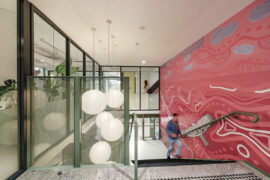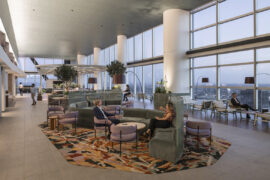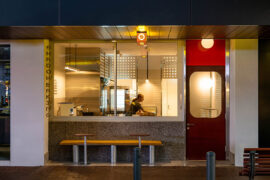Moreau Kusunoki and Genton envisage Powerhouse Parramatta as a hyper-platform with exposed structural elements channelling Parramatta’s industrialist history.

East view of the Powerhouse Parramatta.
August 26th, 2022
Community-shaping projects carry a certain weight and sense of grandeur. They become much-loved institutions for people both close and abroad. The adversity faced by an architect when designing projects of this nature is not simply to create something loved by its townspeople, but for it to gain a reputation on the international stage.
The largest investment for a cultural institution since the Sydney Opera House, Powerhouse Parramatta is shaping up as Australia’s next iconic development. Designed by Japanese-French practice Moreau Kusunoki and local architect Genton, the building has limitless potential, created by an exterior exoskeleton, creating large column free exhibition spaces and extraordinary curatorial flexibility, which enable a constant cycle of ever-changing exhibits, learning programs and cultural and community events.
The architectural team envisage the building as a hyper-platform, which effectively makes for uninterrupted spaces to exhibit the Powerhouse collection and exclusive exhibitions. The design is specific to the culture of Parramatta, with the exposed structural elements channelling the industrialist history and craftsmanship of the Western Sydney region.

“Eliminating complexity is the challenge. Gaining simplicity throughout the entire design is difficult. It’s harder to achieve simplicity because we refuse to accept corners and changes,” says Genton principal, Steven Toia.
“Parramatta is the scene of intense urban renewal currently. The Powerhouse is at the centre of that renewal. We wanted to create a place the community would feel as if it belongs to, and we achieved that through creating a culture specific to Parramatta.”
The vertical design of Powerhouse Parramatta preserves the verdant landscape of the site it sits upon. A Japanese take on interstitial space, known as ‘mâ’ guides the design approach and is key to museum circulation and public space. The lower floor spaces and first layer of lattice are seen as very personal and intricate elements, with the second structural layer reminiscent of the local community. The outer layer, upper gallery spaces and the rooftop terrace address the world stage.
Related: The cultural leaders shaping the Powerhouse Parramatta Landscape Curatorium

“We wanted to create a museum that will be able to be defined by its users decades and centuries into the future,” says Moreau Kusunoki co-director, Hiroko Kusunoki.
“The ‘mâ’ spaces have been left empty and vacant for the future. Our attitude the entire time has been directed towards new possibilities. The sheer generosity of space allows the Powerhouse to accommodate events that aren’t defined yet.”
Powerhouse chief executive, Lisa Havilah, says the design was informed by the idea of redefining what a museum is.
“We wanted to work without precedent in terms of conceiving the programs and what the architectural form is as a result of that. One of the things about museums is that you don’t think of them as dynamic and ever-changing, but we wanted to challenge that notion,” she says.
“We looked at how the museum can contribute more broadly to the community and how it can fit amongst the nighttime community. We’re going to be a museum which will be open as much at night as it is during the day.”

An operable facade measuring an impressive 56 metres in width and nine metres in height opens on the ground plane. The visitor is put at the centre of their visit, and they circulate through the building up the spine which culminates in reaching the garden terrace on the roof. Wayfinding will be intuitive and subtle, with the minimalist aesthetic integrated to keep future use open.
“We didn’t want the Powerhouse to be defined by atypical museum design language. Visitors can remain at ground level and enjoy a coffee and wait for their train. For us, it’s always been about creating a place for the community to utilise at all times, not just when they come to view exhibits,” says Genton’s Toia.
The notion of shirking the museum DNA is furthered amongst the learning spaces with the Lang Walker Family Academy – regarded as a museum first. The academy will provide world-class immersive STEM education experience for over 10,000 high school students from Western Sydney and regional NSW every year, including overnight stays at the museum. Temporary residences for visiting researchers, scientists and collaborators are located on the upper floor. The rooftop terrace features an all-weather structure with Indigenous, productive, seasonal and local plantations.

The museum is targeting the latest 6 Star Green Star rating tool which will result in net zero carbon in building operations, fossil fuel free performance and high efficiency. Lendlease has been appointed as the design and construct contractor working with the architects to bring their vision to reality, with construction anticipated to be completed in late 2024.
Powerhouse Parramatta
maas.museum/new-powerhouse
We think you might like this article on Fender Katsalidis’ landmark for Parramatta Square.
INDESIGN is on instagram
Follow @indesignlive
A searchable and comprehensive guide for specifying leading products and their suppliers
Keep up to date with the latest and greatest from our industry BFF's!

Sydney’s newest design concept store, HOW WE LIVE, explores the overlap between home and workplace – with a Surry Hills pop-up from Friday 28th November.

Merging two hotel identities in one landmark development, Hotel Indigo and Holiday Inn Little Collins capture the spirit of Melbourne through Buchan’s narrative-driven design – elevated by GROHE’s signature craftsmanship.

From radical material reuse to office-to-school transformations, these five projects show how circular thinking is reshaping architecture, interiors and community spaces.

Designed by Woods Bagot, the new fit-out of a major resources company transforms 40,000-square-metres across 19 levels into interconnected villages that celebrate Western Australia’s diverse terrain.

Working within a narrow, linear tenancy, Sans Arc has reconfigured the traditional circulation pathway, giving customers a front row seat to the theatre of Shadow Baking.

At the Munarra Centre for Regional Excellence on Yorta Yorta Country in Victoria, ARM Architecture and Milliken use PrintWorks™ technology to translate First Nations narratives into a layered, community-led floorscape.
The internet never sleeps! Here's the stuff you might have missed

At the Munarra Centre for Regional Excellence on Yorta Yorta Country in Victoria, ARM Architecture and Milliken use PrintWorks™ technology to translate First Nations narratives into a layered, community-led floorscape.

At the National Wool Museum, a new exhibition traces the evolution of Godfrey Hirst and its long-standing role in shaping Geelong’s industrial and design identity.